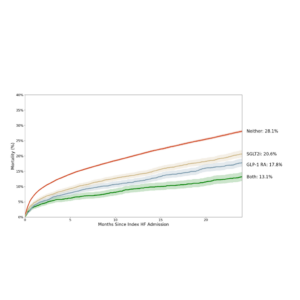
“This research is the first of its kind to look at such a large cohort of AS patients over a four-year span. Findings serve as a stark reminder of the poor prognosis associated with untreated AS irrespective of severity, suggesting patients with moderate AS may benefit from intervention.”
Philippe Généreux, MD, FACC
Director of the Structural Heart Program of Morristown’s Gagnon Cardiovascular Institute and lead author of the study.
BACKGROUND
The American College of Cardiology/American Heart Association guidelines recommend the assessment and grading of severity of aortic stenosis (AS) as mild, moderate, or severe, per echocardiogram, and recommend aortic valve replacement (AVR) when the AS is severe.
OBJECTIVE
The authors sought to describe mortality rates across the entire spectrum of untreated AS from a contemporary, large, real-world database.
METHODS
We analyzed a deidentified real-world data set including 1,669,536 echocardiographic reports (1,085,850 patients) from 24 U.S. hospitals (egnite Database, egnite, Inc., Aliso Viejo, CA, USA). Patients >18 years of age were classified by diagnosed AS severity. Untreated mortality and treatment rates were examined with Kaplan-Meier (KM) estimates, with results compared using the log-rank test. Multivariate hazards analysis was performed to assess associations with all-cause mortality.
RESULTS
Among 595,120 patients with available AS severity assessment, the KM-estimated 4-year unadjusted, untreated, all-cause mortality associated with AS diagnosis of none, mild, mild-to-moderate, moderate, moderate-tosevere, or severe was 13.5% (95% CI: 13.3%-13.7%), 25.0% (95% CI: 23.8%-26.1%), 29.7% (95% CI: 26.8%-32.5%), 33.5% (95% CI: 31.0%-35.8%), 45.7% (95% CI: 37.4%-52.8%), and 44.9% (95% CI: 39.9%-49.6%), respectively. Results were similar when adjusted for informative censoring caused by treatment. KM-estimated 4-year observed treatment rates were 0.2% (95% CI: 0.2%-0.2%), 1.0% (95% CI: 0.7%-1.3%), 4.2% (95% CI: 2.0%-6.3%), 11.4% (95% CI: 9.5%-13.3%), 36.7% (95% CI: 31.8%-41.2%), and 60.7% (95% CI: 58.0%-63.3%), respectively. After adjustment, all degrees of AS severity were associated with increased mortality.
CONCLUSIONS
Patients with AS have high mortality risk across all levels of untreated AS severity. Aortic valve replacement rates remain low for patients with severe AS, suggesting that more research is needed to understand barriers to diagnosis and appropriate approach and timing for aortic valve replacement.
Généreux P, Sharma RP, Cubeddu RJ, Aaron L, Abdelfattah OM, Koulogiannis KP, Marcoff L, Naguib M, Kapadia SR, Makkar RJ, Thourani VH, van Boxtel BS, Cohen DJ, Dobbles M, Barnhart GR, Kwon M, Pibarot P, Leon MB, Gillam LD. The mortality burden of untreated aortic stenosis. J Am Coll Cardiol. 82(22):2101–2109. doi: 10.1016/j.jacc.2023.09.796



